





Hello and welcome to the April 2025 issue of Garden Centre Retail. We’ve had some prolonged periods of nice weather, and households all around my local area have been busy preparing their gardens for the spring and summer seasons. It’s great to hear the whirring of lawn mowers, see the sights of my neighbours pulling weeds and smelling the smells of freshly cut grass. The garden creatures are awaking from their slumbers and there seems to be a positivity around for the good times ahead.
I’ve many personal reasons for enjoying Spring – not least my birthday halfway through April. My young children love being outside in the garden, whether it be with their hands in the mud, doing gymnastics on the lawn or even, on the very rare occasion, having fun with the sprinkler and the water guns.
As far as I can tell, too, the garden retail industry has started 2025 in barnstorming fashion. All hands have been on deck in preparation for the season, signs of life and


colour are blooming and customers are making their way through the doors, ready to spend their money with your business.
According to a recent survey by eBay Advertising, with rising costs putting pressure on discretionary spending, some consumers are prioritising their gardens over leisure experiences. The research reveals that 1 in 10 (10%) of those planning garden purchases are doing so instead of going on holiday.
More than half (57%) of shoppers looking to refresh their outdoor spaces this year are preparing for spring and summer. 39% plan to spend more on their gardens than in the past one to two years, reflecting ongoing investment in home spaces despite fi nancial pressures. This rises to 43% among eBay shoppers specifically.
We’re hoping that this positivity continues for you over the next few months, we all know that the sector deserves a good season. Enjoy the read, and see you in May.
Joe Wilkinson Head of content
Eljays44 Ltd
BizSpace, Courtwick Lane, Littlehampton, West Sussex, BN17 7TL
EDITORIAL
Head of content – Joe Wilkinson
joe.wilkinson@eljays44.com
Tel: 01903 777 587
Content subeditor – Carmel Mary carmel.mary@eljays44.com
Senior Designer – Alex Evans
ADVERTISING
Portfolio director – Luke Page luke.page@eljays44.com
Tel: 01903 777 580
Sales director – Rob Dwyer rob.dwyer@eljays44.com
Tel: 01903 777 573
Commercial director – Estefania Moreno estefania.moreno@eljays44.com
Tel: 01903 959 395
MANAGEMENT
Managing director – Jamie Wilkinson
CIRCULATION
Subscription enquiries info@eljays44.com
Tel: 01903 777 570
Printed by Stephens and George Ltd
Published by ©Eljays44 Ltd
Garden Centre Retail is published by Eljays44 Ltd.
The 2024 subscription price is £125. Subscription records are maintained at Eljays44 Ltd, BizSpace, Courtwick Lane, Littlehampton, West Sussex, BN17 7TL. Articles and information contained in this publication are the copyright of Eljays44 Ltd and may not be reproduced in any form without the written permission of the publishers. The publishers cannot accept responsibility for loss of, or damage to, non-commissioned photographs or manuscripts.
Whilst every effort has been made to maintain the integrity of our advertisers, we accept no responsibility for any problem, complaints, or subsequent litigation arising from readers’ responses to advertisements in the magazine. We also wish to emphasise that views expressed by editorial contributors are not necessarily those of the publishers. Reproduction of any part of this magazine is strictly forbidden.

Our robotic mower range is ideal for small urban lawns and medium-sized rural gardens, all operated remotely via Yard Force CloudHawk™ App.

Our pressure washer range offer compact, highperformance models, perfect for tackling all your outdoor cleaning tasks with ease.

Our lawnmower range includes corded, cordless and petrol lawnmowers for various garden sizes.

Our handheld products include hedge trimmers, grass trimmers, blower vacs, chainsaws and many more products to complete any garden task effortlessly.
The ProRider E559 battery operated ride-on mower is designed to meet today’s demands for greener living by offering zero emissions, and powerful cutting for total user comfort.
Twin blade cutting deck
96cm cutting width
12 adjustable cutting heights
Mulch, side chute, collect & reverse mow
LCD display showing battery level & mileage Advanced control panel & LED headlight
Cup holder & USB-A charging port



Our lifestyle range includes both indoor and outdoor products, for life and power on the go.
At Yard Force, we’re passionate about helping people create and maintain beautiful outdoor spaces with innovative, high-performance equipment. Our mission is to bring efficiency, ease, and joy to gardening and outdoor maintenance.

56V/50Ah lithium LFP battery, zero emissions 90 min runtime
Compact design, large front wheels enabling a tight turning circle Adjustable seat, cruise control, & patented parking brake
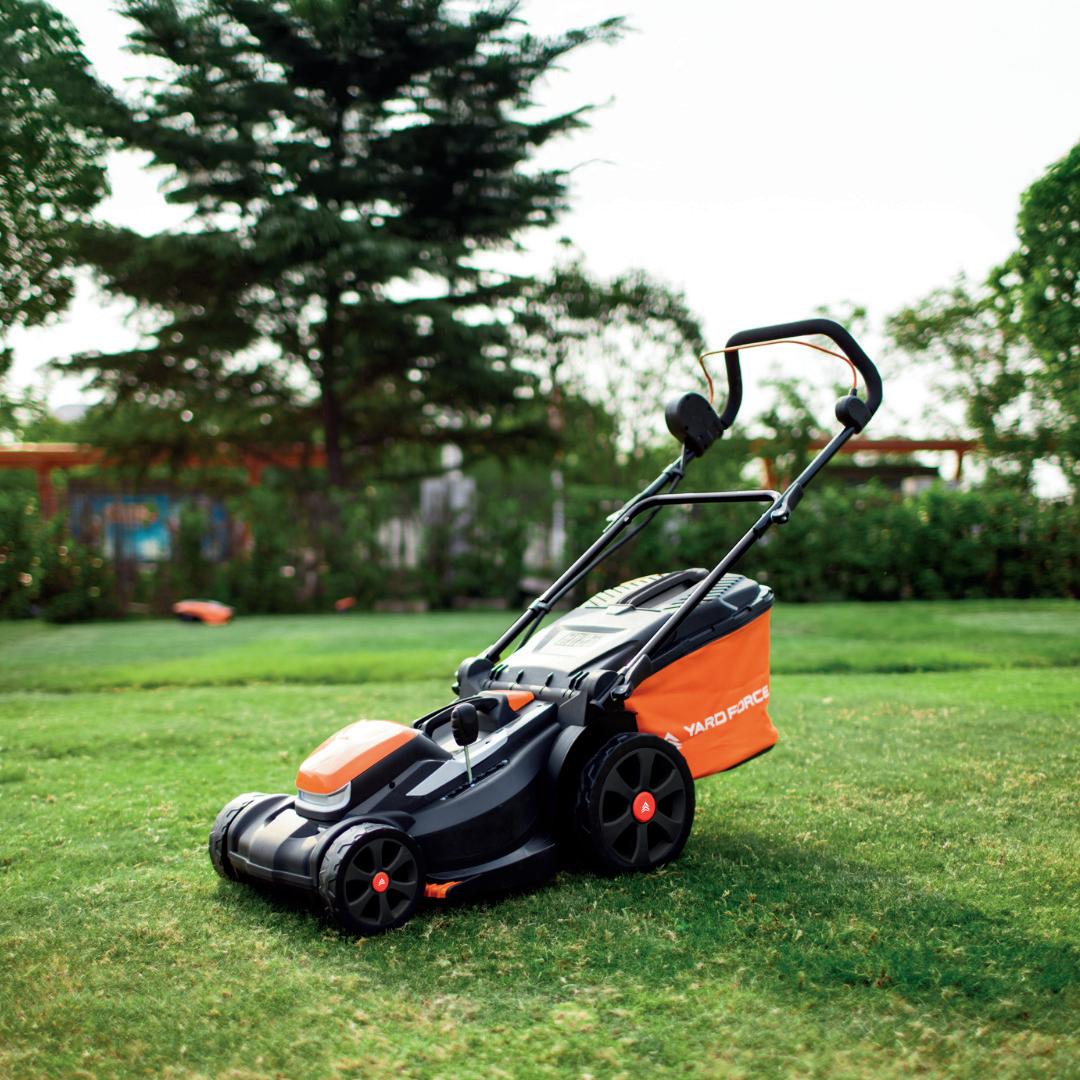

The NEW Yard Force CR20 range offers a variety of garden power equipment to achieve all gardening tasks, powered by our CR20 battery platform.
FOR THE COMPLETE CR20 RANGE




06 08 10 14 15 19 22 26 30 33
The benefits of being a GCA member
Peter Burks, CEO of the Garden Centre Association shares his thoughts on why garden centres should consider GCA membership, and the benefits that being a member offers.
Getting to the core of gardening
With the season now in full swing, GIMA members offer their insights into core gardening lines; giving retailers the lowdown on key trends, challenges, innovations and opportunities in categories from compost and lawncare to garden tools and irrigation.
Increasing profit by making your ‘cake’ bigger and better
Andrew Burton of Pleydell Smithyman discusses how garden centres can diversify to increase profits and cover increasing costs.
The Growing Importance of Experiential Marketing
Holly Daulby, managing director of specialist home and garden PR agency, Honest Communications, discusses the importance of experiential marketing in the garden sector.


18
Garden Centre Retail catches up with Edward Campbell-Preston, acting managing director of Capital Gardens, a London-based garden centre with six stores. Edward shares his history, his current role and his views on the sector.
An interview with Edward Campbell-Presto Omnichannel marketing in garden retail and cultivating growth in a digital age
Cassie King shares how modern & younger consumers look for seamless experiences across multiple touchpoints, blurring the lines between online & offline interactions.
The Psychology of Garden Centre Design
Garden centres are more than just retail spaces; they are destinations where customers can immerse themselves in nature, find inspiration, & enjoy a peaceful shopping experience.
The best perennial plants that garden centres can sell this season
Garden Centre Retail catches up with Colin Stanley, retail sales manager at Wyevale Nurseries to get his views on the best Perennial plants that garden centres should include in their plantarias this season.
Brewing Success
In the ever-evolving landscape of garden centres, the integration of quality coffee services has become a significant trend. To delve deeper into this phenomenon, we sat down with Caine Le Tissier, sales manager at Coffee King, to discuss their journey.
Trends in gardening tools
In 2025, several exciting trends are emerging in the gardening tools market, making gardening more efficient, sustainable, and enjoyable.

26

30

Peter Burks, CEO of the Garden Centre Association shares his thoughts on why garden centres should consider GCA membership, & the benefits that being a member offers.
Earlier this year we hosted our annual Garden Centre Association (GCA) conference, which highlights many of the great reasons for being a member of our association.
The event, which is held over three days, gives all the delegates time to meet, relax, and interact with each other. It enables great conversations about all the current issues and opportunities in the sector to be aired. Discussions are held in the tea and coffee breaks, lunch breaks and over dinner in the evenings.
This year’s street food theme on Monday evening certainly enabled a lot of mingling between groups and the ability to join in many different conversations.
I remember my main reason for joining the GCA, twenty years ago, was so that I could talk with like minded businesses and fi nd out if my thoughts and opinions reflected the wider industry.
Ideas I had, to make changes to my garden centre, could be discussed with people who had already done these and they were happy to share if the activity was a success or not. Very valuable advice.
One of the most valued aspects of membership in the GCA is the annual inspection. This is a mandatory feature that occurs every year between mid-March and mid-June. We have a team of four industry experts who will arrive, unannounced, at every centre and conduct an inspection that currently features 220 different factors.
Linked to these factors are specific criteria, meaning the inspectors are tied to looking for
this information, ensuring the judgement is objective and personal opinion is significantly reduced.
We hold several consistency days with the inspection team every year to ensure that scoring is unified and that all inspectors view the factors similarly. During these days, even specific words in the criteria can come under intense scrutiny to ensure there is no doubt what the inspection form is looking for.
Once the inspections are complete, the top three highest scoring centres, in each of the three turnover bands that we divide the membership into, get a second unannounced inspection.
This is to see if they maintain their standards across the year. We then hold Area Awards Nights in July with the winners in each inspection category, for example, catering, plants, indoor lifestyle etc, being announced for that region.
These are often sponsored by our associate members for which we are very grateful and in return, they get some excellent publicity. We have four regions south-east, east, north including Scotland and Northern Ireland and Midlands, Wales and the west.
At our annual conference the overall, country-wide winners are announced to a great fanfare. Wonderful opportunities for local press coverage follow for everyone involved including the runners-up.
Belonging to our Barometer of Trade is another very useful benefit to membership, as it gives members the chance to benchmark their fi nancial performance against their peers. Again, probably of greatest benefit to single
site or small group members, who otherwise do not know how their performance is ranked in comparison to the wider industry.
About 12 years ago, the GCA started an online learning platform named GROW. This has grown into a catalogue of almost 100 courses under the direction of our Instructional Designer Antony Snow.
These courses cover horticulture, catering, health and safety and legal compliance and are now accessed by more than 13,000 members of staff . They can be accessed day and night 365 days a year.
Many members now use these as an important and integral part of their induction process. The catalogue is still growing and is now at the point where members do not need to access any courses elsewhere, another good fi nancial saving in these potentially diff icult times.
About Peter Burks
Peter Burks, CEO of the Garden Centre Association, is a fullytrained horticulturalist and has worked in directorial and management roles for over 40 years. Peter helped set up and run the multi-award-winning Sanders Garden World in Somerset. He also became regional manager of the South West for Wyevale Garden Centres, and general manager for Trelawney’s in Cornwall, and managing Fermoy’s Garden Centre in Devon. gca.org.uk





With the season now in full swing, GIMA members offer their insights into core gardening lines; giving retailers the lowdown on key trends, challenges, innovations and opportunities in categories from compost and lawncare to garden tools and irrigation.
Gardeners can struggle to make choices about peat-free and don’t always select the right product for the job, leading to disappointing results. New research found that more than one in five gardeners are confused about different compost types and what makes them sustainable. Despite nearly 90% of amateur gardeners saying they support a complete ban on the sale of peat products, a lack of education is impacting sales, making it tough for retailers who are keen to stock alternatives.
Durston Garden Products Ltd director, Dan Durston, says: “The main hindrance in the compost category is confusion about how to grow and care for plants in peat-free. Gardeners have used peat products for so many years; that they are accustomed to how it will behave, which is why many have shied away from making the switch.”
Dan continues: “We want to build confidence in peat-free by giving gardeners the information they need, supported by our game-changing range that has consistently outperformed competitor products and even traditional peat products in independent
growing trials. We are also part of the peatfree communications partnership to provide accurate and consistent guidance around peatfree growing media.”
Durstons’ range is enhanced by Gro Fibre, a cutting-edge wood fi bre that ensures optimal moisture control without Nitrogen lock-up, and Gro Boost – a 100% natural, renewable ingredient that enhances organic matter, nutrients and beneficial microbes.
Another supporter of the peat-free communications partnership is Southern Trident. Discussing the company’s latest launch, CEO Steve Harper says: “As the gardening world shifts to peat-free, Little Big Compost leads the way. This compressed coir compost expands up to 15 times its size with just water, providing a sustainable, highperformance alternative. “The All Purpose blend has won four Which? Gardening Best Buys in the past two years, proving it’s the best peat-free compost available. Now in selfexpanding bags, it’s even easier to use—just add water for instant, fluff y compost.”
Sipcam Head of Sales & Marketing, Nigel Thompson offers his take: “As we move into the 2025 season, the peat-free movement
continues to generate significant discussion within our industry, with many focusing on how best to support customers with their peat-free compost projects. Peat-free compost works differently, which is why ecofective offers tailored solutions that complement it.”
He continues: “Our Organic Superfood is perfect for boosting plant health in peat-free compost, providing essential nutrients for thriving gardens. Additionally, our Natural Water Storing Granules keep plants well hydrated by retaining water around the plant’s roots. Together, these products create the ideal partnership for healthy, sustainable, peat-free gardening.”
Also helping gardeners achieve growing success and providing add-on sales opportunities for retailers is the Bronte Heritage Collection. commercial director, Richard Baker explains: “As gardeners continue the transition to peat-free composts, many are fi nding challenges with water retention and microbial activity. To address these issues, we have introduced two solutions – AquaBoost and TripleBoost – designed to bring professional-grade performance to home gardening.
“Many peat-free composts rely on wood and coir-based materials, which can be diff icult to wet and naturally contain little microbial activity. AquaBoost and TripleBoost have been developed to overcome both of these challenges, ensuring better water management and enhanced root health.
AquaBoost is a granular wetting agent formulated with a unique blend of polymers. It ensures compost absorbs water evenly and remains rewettable for up to six months, preventing dry patches and improving plant hydration. Meanwhile, TripleBoost is a powerful microbial inoculant containing three strains of beneficial bacteria. It increases microbial activity in peat-free compost, fostering a healthier root environment and improving plant vitality.

Garden tools and watering Burgon & Ball managing director, Rainer Schubert offers his advice to retailers: “In the present challenging economic times, look to offer ranges with a compelling point of difference, which can still tempt shoppers to spend – such as the unique proposition of our new RHSendorsed BoronGreen tools. We believe BoronGreen to be the fi rst UK range to combine the superior performance of boron steel, coupled with advanced sustainability ambitions.”
inspire their audiences with ever more exotic crops, the popular demand for a means to raise unfamiliar varieties with ease has never been greater. AutoPot Watering Systems can satisfy that demand for gardeners of all abilities.
“Our automatic plant watering systems irrigate and feed only in accordance with plant uptake. Because of this, we offer a truly responsive way of cultivating the wildest, most diverse range of plants imaginable. Better still, the systems operate power-free, with zero waste, and no need for mains water, meaning anyone can set up a garden in practically any space and leave it to thrive unattended, in confidence.”
Whilst the cost-of-living crisis continues to put the squeeze on consumers, the drier start to the spring is keeping gardeners spending on core lines, believes RocketGro managing director, Toby Thomas. “The weather can be unpredictable, but one thing we know is that core gardening always sells,” he says. “Buying a £30 rhododendron bush is discretionary but customers need their bags of compost–it’s not something gardeners can do without–which means, even if they are watching their spend, they will still be leaving garden centres with a product.” He continues:
“Our multi-purpose 50-litre compost is now the number-one bestselling compost in dozens of garden centres. Our range of British-made peat-free and coir-free composts are Soil Association
Approved Organic, 100% sustainable, and powered by digestate fi bre with two added Organic Fertiliser Superfoods for a full 3-month+ feed. Another favourite is our Magic Mulch, which offers gardeners huge benefits, including improving soil health, protecting plant roots, adding porosity, retaining water and also keeping slugs at bay.”
Helping gardeners create a thriving lawn, Greenkey’s Rolling Lawn Aerator is billed as the secret weapon for effortless garden maintenance. Voted BEST BUY by BBC Gardeners World Magazine, it’s the ultimate tool for maintaining a lush, healthy lawn. Designed for gardeners with small to medium sized lawns, it saves time by eff iciently piercing the soil using the rolling head, allowing air, water, and nutrients to reach the grassroots. Its user-friendly design makes it easy to use, reducing the effort needed to achieve professional-quality results.
Creating exciting new opportunities in lawn care and tapping into the rewilding trend, Johnsons Lawn Seed is proud to introduce Nature’s Lawn with Mowable Native Wildflowers, an innovative seed mix that combines the practicality of a usable lawn with the ecological benefits of a thriving wildflower meadow. Unlike meticulous, weed-free lawns, which offer little support for pollinators, Nature’s Lawn boasts a carefully-selected blend of slow-growing durable grasses and UK-native perennial wildflowers that can tolerate regular mowing.

Helping retailers cater to increasing demand for more ambitious growing endeavours, Laurence Ritchie, UK & international sales manager, AutoPot Global Ltd says: “As online growers entertain and
Another product that makes irrigation easier is the FITT NTS Yellow; a soft, robust, and malleable garden hose suitable for daily and professional use. Thanks to NTS (No Torsion System) mesh technology, the hose remains free from knots and twists, ensuring a constant and perfect water flow even under intensive conditions. The external surface, enhanced with Sky Tech technology, increases resistance to cuts and abrasions and makes the hose frictionless on all surfaces, including corners. These features make FITT NTS Yellow the ideal ally for watering vegetable gardens, and performing all outdoor cleaning activities.
GIMA is a membership organisation of around 170 companies representing the majority share of suppliers and manufacturers operating within the UK gardening industry, together with an estimated £4bn in annual trade.

GIMA’s goal is to promote the commercial, trading, and industrial interests of its UK and EU-based members supplying the UK garden retail industry. Run by a small team of dedicated professionals and governed by a council of members, GIMA is funded by membership subscriptions and services. The range of services and support provided for members is extensive, offering something for all members, regardless of their size or heritage.
More Information About Gima Kimberley Hornby George kimberley@hornbygeorgepr.com Tel 07851 610573

2025 is a year when everyone in the garden centre industry is reviewing their business models, to ensure that what they do generates the profits they need to cover the increasing costs.
Working alongside several businesses within our industry, I have seen different approaches including reviewing their processes, looking at staff ing schedules, challenging costs in their overheads, focusing on layout and customer flow and enhancing their existing customer proposition.
These reviews are essential in the current climate and relevant for every business, and the garden centre industry isn’t alone in this. However, without this review, 2025 is going to be a hard year because anyone who doesn’t adapt will see profits hugely impacted. Covering the potential impact on profits is going to take a mix of strategies, and I reflect on something I hear Paul Pleydell talk about a lot which is that “it takes ingredients to make a cake, and it has to be the correct ingredients.”
This statement resonates in many projects and aspects of business development, but when we reflect on that in relation to profit, from the ‘cake’ I want to focus on ‘generating more profit from increasing income potential.’
This profit focus work might be done in a number of ways – which are essentially the ‘ingredients’ to make the profit cake. These ingredients could include reviewing the business performance by department, looking at additional revenue streams, or looking to expand into other areas.
Reviewing your business performance (does your cake have the potential to improve) Garden centres have a lot of data, often referred to as benchmarking data. This benchmarking data essentially tells us ‘what good looks like’ and what is performing well, and crucially what isn’t doing so well. What this data does is allow us to identify turnover and profit opportunities throughout the garden centre. Whether this is turnover or margin opportunities, the data tells
us where opportunities lie, and this enables a business to do something to generate profit.
It may be to do this, a garden centre needs to develop by shrinking space on one department to create space to increase another, or improving customer flow and hot spots to lift average transaction value, or simply improving retail standards and ambience. It can also lead to development that introduces a new income stream such as an improved catering offers, or a strong retail food offer, both of which have shown significant growth in the industry and are proven to work adding footfall all year around. Or it could be the introduction of an experience such as an indoor play area; whatever it is, the benchmarking exercise is essential and something every good garden centre should do.
An essential point to this benchmark work is that this can be done quickly and effectively to potentially identify ‘low hanging fruit’ for 2025. It is obviously important to use the correct data, so benchmarking is carried out

on a ‘like for like’ basis with similar business models, but for anyone who has not done this, you may well be missing a big opportunity that doesn’t take much to sort out.

Looking at additional revenue streams (making a bigger cake)
It is sometimes the case that garden centres have maximised their customer offer within their centre already (in essence – their cake can’t get any bigger internally), or they are in
a situation where capital expenditure is not available to create new areas. However, we often see opportunities that could generate income for a business away from the core retail areas. This is done by utilising land and buildings surrounding the garden centre by introducing income streams that may be thinking outside the box.
The team I work with has been working on a number of these in recent months within garden centres, farm shops and farm park clients we work with. There have been a mix of options that have been considered, including things such as caravan storage, container storage, dog walking fields, doggy day care, small retail outlets, external concession space, sustainable energy development and event development such as tulip fields and improved Halloween events. The list goes on and on, but should a business have land and/or buildings available, then these land/building assets can all be analysed to identify opportunities.
Expand into other areas (making a new cake)
It can also be the case that landlocked garden centres have nowhere to expand. The garden
centre is working well internally and there is no land externally to adapt. However, businesses can think beyond their boundaries. Whether through purchasing additional land, acquiring another garden centre, or entering new business areas using their expertise—such as opening a high-street café that also sells selected products—expansion could generate long-term profits to support a business overall.
About Andrew Burton
Andrew works for Pleydell
Smithyman as an associate director, focusing on garden centre and farm shop advice, with an overarching aim of business strategy and development. He provides site development and commercial and operational support. He sits on the Farm Retail Association Council, and previously on the Garden Centre Association Board. andrewb@pleydellsmithyman.co.uk

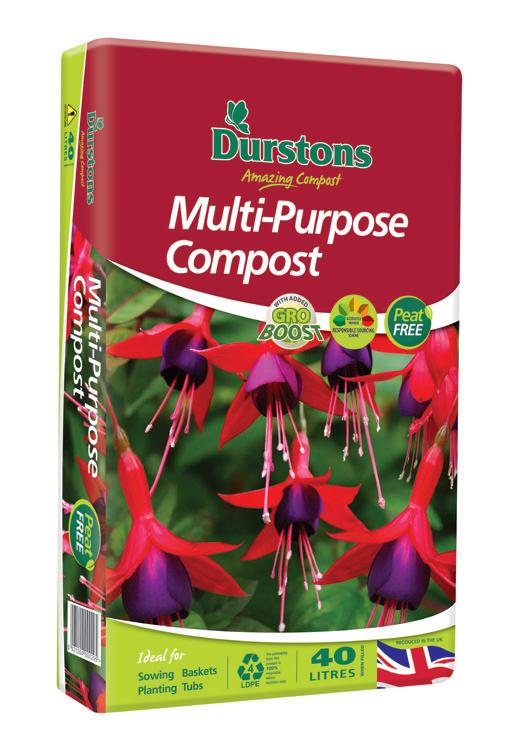


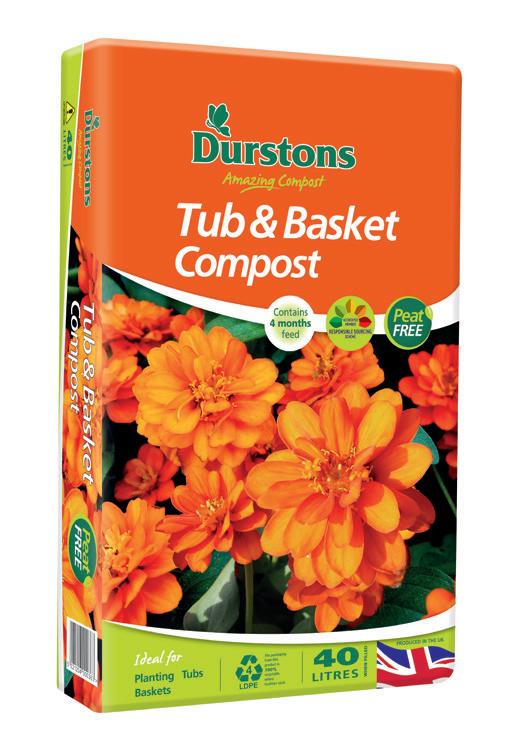







Holly Daulby, managing director of specialist home and garden PR agency, Honest Communications, discusses the importance of experiential marketing in the garden sector
As the gardening industry continues to flourish, experiential marketing is becoming even more essential for brands to truly connect with their audience. In today’s world, consumers seek more than just a product –they desire memorable experiences, especially in a sector like gardening, which thrives on creativity, education and inspiration.
Studies show that 9 out of 10 shoppers love experiencing a product fi rsthand, proving that companies that invest in experiential marketing are more likely to attract consumers and build long-lasting relationships with them.
What is experiential marketing?
Experiential marketing invites consumers to participate in an experience with a brand rather than simply passively receiving a message. It enables customers to immerse themselves in a brand’s story, products, and values through activities, live events, demonstrations, or other interactive engagements.
Why is experiential marketing so important in today’s world?
In an increasingly digital world, people crave authentic, tactile experiences. Experiential marketing taps into this desire for real-world connection. It is a powerful tool for marketing and brand loyalty, fostering community and providing educational value.
As people continue to invest time and effort into their gardens, they seek inspiration, tips, and the tools to bring their vision to life. Experiential marketing encourages
customers to feel the textures, see growth, and understand product impact in real-life settings – all while conveying a brand’s key messages.
Here’s why it matters:
• Building emotional connection: Gardening is about creating beauty and boosting wellbeing, and consumers want to feel that connection when interacting with a brand. By crafting immersive experiences that engage the senses—such as hands-on workshops or interactive displays—brands can deepen emotional ties and foster long-term loyalty.
• Brand differentiation: In an industry saturated with online content, providing tangible, real-world experiences helps a brand stand out. Hosting events, pop-ups, or in-store demonstrations allows consumers to engage with products in a meaningful way, creating memorable moments that digital marketing alone cannot achieve.
• Increasing brand awareness and loyalty: When consumers are actively engaged with a product or service, they are more likely to share their experiences with others, either through word of mouth or social media, thus increasing reach and fostering loyalty.
How can brands use experiential marketing in the gardening sector?
The keys to successful experiential marketing are authenticity and engagement. Gardening brands can tap into these opportunities in several effective ways:
• Interactive events and workshops: Hosting hands-on gardening workshops, such as DIY
planters or landscaping tutorials. A great example of this is when brands like David Austin Roses host ‘Pruning Workshops,’ enabling potential customers to directly interact with products while learning valuable tips.
• Pop-up gardens and demonstrations: Setting up pop-up garden installations allows customers to physically interact with the plants, tools, and products. A great example is the plant pot pioneer Elho, who supports local neighbourhoods in Holland with their ‘Green Doers’ campaign.
• Gardening experience centres: Large gardening brands can set up dedicated centres where customers explore garden designs and interact with plants in an immersive environment. Virtual or augmented reality can also simulate the gardening process, engaging tech-savvy consumers.
Experiential marketing isn’t just a buzzword; it’s a powerful way for brands to connect with their audience on a deeper level. It’s about creating meaningful interactions and memorable experiences that resonate long after the moment has passed.


Garden Centre Retail catches up with Edward Campbell-Preston, acting managing director of Capital Gardens, a London-based garden centre with six stores. Edward shares his history, his current role and his views on the sector.
Avery traditional garden centre business, Capital Gardens’ history starts with an independent landscaping business in 1981 set up by Colin CampbellPreston and his wife Rosemary, parents of Edward Campbell-Preston.
Having been surrounded by horticulture and plants for his whole life, Edward joined Capital Gardens five years ago. Following his studies in sustainable chemistry at the University of Edinburgh, Edward worked in a senior management role at Suez Group, Paris, working on operational performance in the waste management sector. “It’s fair to start by saying that I’m quite a new person into the sector, however, I’ve now got five or so years of experience at Capital Gardens, and
I’m looking forward to taking the business forward for the next phase of its future” explains Edward.
And he’s now the key driver in the business, but what does his day-to-day work involve? “It’s very pluralistic”, says Edward. “You could say I’m the sort of acting managing director of the company with my father and Anna Lamarche advising me along the way.
“There are three main pillars to my day-to-day work. My main focus is ensuring the business stays true to its roots as an independent garden centre and for me to stay deeply engaged with its operations on the ground, day to day, with the help of our new operations manager. Where we are right now, pre-season, is an exciting and very busy time for us.
“The second is my focus on more long-term project management and capital expenditure investments into our existing sites.
We have several exciting projects that we’ve got underway including projects in the technological sphere, improving eff iciency in the way that we work.
“And then my third focus is to continually review our long-term strategy and the direction of the company; building a team and a culture to support the next phase of the company’s growth.”
The business currently has six centres in the south-east, but acquisitions may not be far off in the future. Edward is constantly monitoring the market and is interested to see what

opportunities there are to increase the footprint of the business.
Says Edward: “Our management style and culture, as an independent business, is built around our hands-on approach, with the head off ice team getting involved daily with these centres, meeting the teams and really being involved in all aspects. This is a fundamental principle of our business so the geographical positions of our centres are therefore important, so we can get around to all the sites. And absolutely, we’re looking at new acquisitions to expand this way of working.”
Challenges and building teams
Edward is very keen to heap praise on the amazing team around him, which is helping him navigate myriad challenges within the business. One of his aims is to continuously improve on the legacy of high-performing teams, and this poses its own challenges.
“Coming back to the broader macroeconomic picture, we mustn’t forget that there is war in Europe, there’s been challenge on inflation, interest rates, the market is going through a diff icult phase at the moment”, he explains.
“Trying to dissect that and also being bold and sticking to our strategy and our plan navigating forward is challenging.”
Edward’s gratitude to his team is plentiful. He is building a senior management team
that he trusts and relies on, and it’s paying him back in abundance. He says, “We’ve got a new operations manager who has come into the business at the end of last year, who I work very closely with on the day-to-day management of the business, which is vital.
“Then I’ve got my buying team who are based across several different centres who are given quite a lot of autonomy to go out and fi nd exciting new products, new companies entering the market and new ways
of doing things. Alongside these roles, we have a group marketing manager, a customer service manager and an accounts team.
“Beyond that, we are quite lean. We have my father, Anne Lamarche and our Board. There is also a lot of focus on teams at centre level where we put a lot of our energy and our resources.”
“Having boots on the ground is imperative for Capital Gardens – the business understands the importance of local communities and aims to get closer to customers to drive future business decisions.”
Having boots on the ground is imperative for Capital Gardens – the business understands the importance of the local communities and aims to get closer

to the community and our customers to drive future business decisions. After all, retail thrives when supply and demand are balanced.
Having studied sustainable chemistry, it’s no
surprise that Edward is keen to get involved in the great work the industry is doing in this realm. So, it’s no great surprise that he has some strong views.
He says, “We engage in a lot of partnerships with our suppliers on specific initiatives.
For example, we have a potted Christmas tree returns scheme with Needle Fresh.
“The customer returns their potted tree, and this goes back to Needle Fresh, who commit to planting that tree for 35 years, and that’s really powerful.
“Obviously, we have a commercial interest to sell more potted Christmas trees and other living products, but this also aligns us with our sustainability goals. These products and initiatives play a role in the wider carbon cycle; reducing net carbon dioxide in the atmosphere and supporting a healthier environment.
“That message is something that we are constantly looking to improve within our offering and our sales but also being aware of the sustainability benefit that it brings.”
for Edward and his Centres, particularly as this is another area where they have been led by their community and customer base.
“We moved quite early on to peat-free compost. Interestingly, that was driven by customer demand.
With five years in the sector now under his belt, Edward’s focus is turning towards the future. “I want to see, and hope to see, new entrants into the sector with new startsups and existing independent businesses being retained from one generation to the next.
“I don’t know how that’s going to play out but I really hope that that will happen and the sector will remain dynamic”.

“We want to work closely with the GCA and HTA, and the fundamental message is that our core product, plants, are incredibly sustainable. More could be done perhaps in the future to really sing that song, whether that’s to our customers, the education sector, or the politicians, we should try to inspire and educate not just about the great creativity that goes into building our own garden spaces, but the scientific and the sustainable story that comes with that.
“We can be happy about the fact we work in this sector with regards to sustainability.”
On a more local level, sustainability is key
“I really would like to support smaller growers and new businesses coming in with new products and new plants and I’ve tasked my buyers to keep a track on this.”
“I also want to challenge a bit of the prevailing narrative in the media at the moment about our sector. I think a lot of this has been quite fickle and downbeat. We’ve seen in the past few days some glorious sun and a massive turn around for all of us. Everyone reading this will know that we’re on to a good year as it stands, but we all know that might change because at present, we are utterly dominated by the weather.
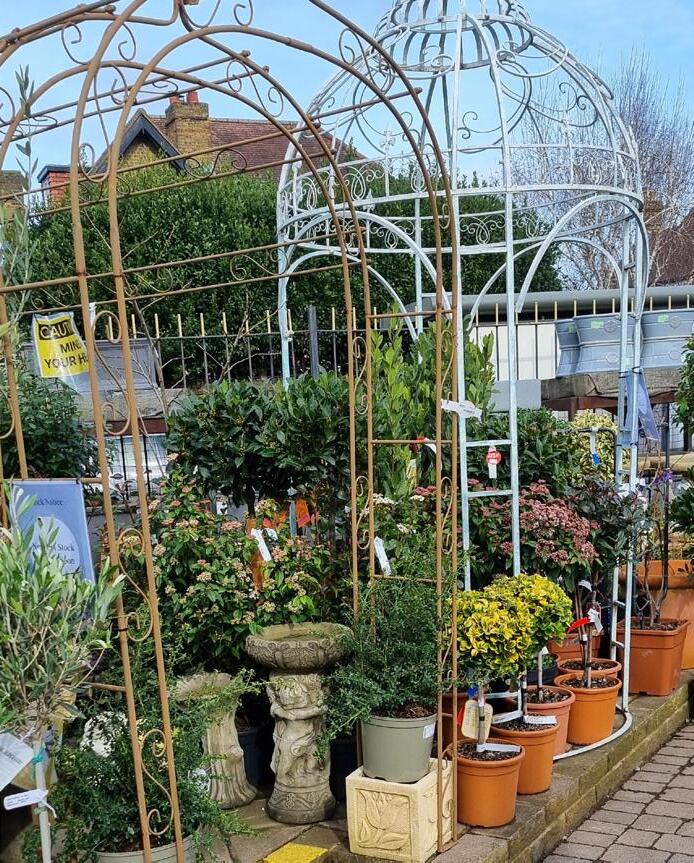

“For anyone wanting to get into our sector, it is an exciting place to be. It’s got this wonderfully strong history that’s part of the fabric and culture of British society.
“But it also brings exciting innovations. With the technology revolution underway, companies are doing fascinating work. We’ve joined a working group with our partner, Davidson Richards, and are seeing interesting case studies in how we analyse and use data in our business.”
As Capital Gardens enters a new phase of business, Edward’s passion for the company and the sector is sure to shine through. And if all his plans come to fruition, the business is surely going to be a force to be reckoned with going forward.

The UK garden centre industry is experiencing a period of transformation. While the traditional appeal of wandering through a plant area, picking out containers and choosing compost still exists, customer expectations are evolving.
HTA research shows that in 2023, internet sales represented 11% (£218 million) of the £1,975 million spent on outdoor plants and 9% (£62 million) of the £692 million spent on houseplants, online channels were significantly stronger for garden furniture (39% of £1,021 million total spend) and powered/ non-powered tools (32% of £1,115 million total spend). The study also indicated that internet usage was highest among younger consumers (25-34-year-olds at 15% for outdoor and houseplants) and also for older consumers (65-74 and 75+ age groups), likely due to the convenience of online shopping.
For a UK garden centre to succeed, it must drive sales through omnichannel marketing, which integrates multiple platforms for a unified customer journey. This approach is vital due to evolving customer behaviours, competition, and the rise of mobile devices
boosting sales in a digital landscape.
We speak to some key retailers about balancing the traditional charm of a garden centre that draws customers in with omnichannel approaches to capture today’s digital consumer and ensure future growth.
Over the past few years, Bents Garden & Home has significantly increased its digital and social media presence as Helen Bent, head of marketing, explains: “This is now a much larger and important part of our marketing mix because it is so measurable, instant and impactful. E-commerce is an essential part of our business but a fairly small percentage of our overall sales. We see our website as a gateway to our destination, and our main focus in terms of e-commerce is to ensure that it is a profitable operation and a positive contribution.”
In today’s fast-paced digital world, garden centres must adapt to new marketing strategies or risk being left behind. Helen continues:
“When done effectively, digital marketing can create exposure and awareness to drive footfall. Social media and online activities such as Reels, TikTok and influencer videos help create the hype and the ‘must-visit’ mentality, like traditional word of mouth. Online ‘word of mouth’ will spread the word faster and create hype quicker, and those garden centres and businesses that choose not to embrace digital marketing will miss out.
“It allows us to engage with our customers regularly, keeping our messages fresh and up-to-date, and by engaging in two-way communication, we build trust and loyalty. “
Sarah Murray, digital product manager at Dobbies, states that retailers face risks if they do not invest in digital and e-commerce. “There is a risk of losing visibility and relevance in an increasingly competitive market. With supermarkets and online marketplaces like Amazon expanding their gardening product ranges, it is essential that garden centres not only showcase their
offerings but also highlight their knowledge and expertise to guide customers in making the right choices for their garden spaces.”
Digital marketing is important for Cowell’s Garden Centre, which maintains an active presence on social media platforms. Sam Clark mentions, “Our main platforms are Facebook and Instagram. Gen Z and millennials engage more with us on Instagram, whilst slightly older age groups consume through Facebook.
“Houseplants are one of the most popular on social media – we recently did some focused advertising in the new year with our ‘Replace Your Tree With Me!’ campaign. This generated nearly 2000 views on both Facebook and Instagram and attracted an audience of new homeowners to the store.”
Joe Aldworth, marketing manager at Old Railway Line Garden Centre, has also found they have had to evolve: “Things are always changing—new technology, more competition, and shifting customer habits. Without a strong online presence, it’s easy to get left behind.
“We’re active on Facebook, Instagram, and TikTok, sharing gardening tips, new stock, offers, and fun content to keep people engaged and coming back. Different platforms offer different opportunities to engage potential new and old customers.”
Ferndale Garden Centre uses its website as a shop window, says Neil Grant, managing director: “We add helpful articles to show our expertise and social media, especially Instagram, is helping to drive traff ic to our site.
“When we post about our team or feature people, it tends to get more attention than product-based content. However, timing is essential for many gardening items as people assume it’s the right time to ‘do it’ at home. The sales impact can jump by 200300% for more obscure plants and products that customers don’t ‘see’ when they look at a stand of products. That’s when linking to a single product page with good information on a webpage can be so beneficial.”
The shift to online shopping is reshaping the retail landscape, and garden centres are embracing e-commerce to thrive. “Sales online are defi nitely growing,” says Neil. “This is a common theme on my garden phone. Like all retail, people like convenience and have their phones & tablets with them while watching TV.”
Dobbies continues to enhance its digital presence and e-commerce offering,
Sarah explains. “With many customers using our website as a research tool before visiting our stores, we must provide a comprehensive and inspiring showcase of our ranges online. We continually review our product ranges to ensure strong availability across our core categories, particularly outdoor living and gardening.
“Organic and paid search play a key role in reaching our most engaged audiences, ensuring that customers can easily discover our products when searching for gardening and outdoor living solutions. Google Shopping is particularly effective in directing potential buyers to the products they are looking for, streamlining the path to purchase.”
Cowell’s embarked on its e-commerce journey with the launch of its web shop in 2016. What started as a website selling premium perennials has evolved into a thriving online store selling an extensive range like in-store. “Our website initially started as just perennials; Sam tells us. “Then we started adding different categories, including houseplants, which caused sales to skyrocket and opened the floodgates.”
With more ranges online, Cowell’s customers now extend beyond its NE postcode. “We are now delivering nationally, including to address in the south of England and London, explains Sam. “In 2023, website sales accounted for 10% of our total income. Houseplants is still the most popular seller, when we add unusual varieties online.”
For a country-based retailer like Old Railway, online is vital in driving the business forward, as Joe tells us: “We’ve grown a lot in recent years, with a bigger team, a better website, and new tech to boost our digital presence. Being a rural business, we work harder for footfall, so digital marketing and e-commerce are a big part of our growth plans.
“We try to integrate online and off line experiences to create a seamless customer journey, but it’s not easy, Joe continues. “It takes time, effort, and constant tweaking. We’re always working to ensure that our website, social media, and in-store experience tie together smoothly. We use email marketing, SEO, and special offers, whilst click-and-collect that brings people to our website.”
Hillier’s e-commerce solution offers national delivery from our central warehouse based on its nursery in Hampshire, with a smooth and coherent experience for shoppers. Chris Francis, director of retail, said: “This enables us to look after plants in the nursery until an order is placed and then deliver directly, maintaining high-quality care until despatch.
“There are also order and delivery updates on the website and email. All this needs to be set up to be automated in real-time to ensure the accuracy of stock levels, make the order processing as eff icient as possible and enable scale and growth. There are plans to enhance this with additional distribution channels, enhanced functionality and ordering options to


increase average transaction values, and now solutions to provide customers with a more personalised online experience.”
British Garden Centres has recently enhanced its e-commerce platform to engage with the next generation of gardeners.
Katie Henderson, head of online, email and e-commerce marketing, elaborates: “Last year, we invested in a new website that integrates our online store and information website into a single platform. This enhancement has increased functionality and made the site more user-friendly. It gives our customers choices and allows the brand to reach new customers nationally who may not live near a centre.
“We continuously work on improving the website by incorporating customer feedback to ensure a seamless online experience for all shoppers. We are expanding our online product offerings and providing customers with the same great deals available in-store, such as our Best Buy products.”
Helen at Bents adds: “We always pride ourselves on our service levels, and this is one area we can replicate online. It is one of our strong points with customers always able to get hold of a person to speak to and deal with their enquiries and needs.”
Exclusivity is something that keeps people coming back to the Bents online store. “Our buyers are also consistently working on exclusive products for online offerings to help us stand out–margin and price can easily be replicated so we try not to compete there,
instead, we try to focus on exclusivity, for example, some of our Christmas themes and the way we categorise the linked products are pretty unique.
Our e-commerce site is great for event tickets and Bents vouchers and experiences, all are unique to us.”
Data analytics are also important in omnichannel marketing to understand customer online behaviour and personalise marketing efforts.
“We look at what people are buying and browsing so we can send them relevant offers and content that match their interests. People expect tailored and personalised marketing now, so we try our best to keep things relevant to them,” said Joe.
Bents also collects a lot of customer data from its loyalty club membership, which allows Helen and her marketing team to identify and segment different groups of customers, which they can then use to target online lookalike audiences. QR codes have made a huge comeback and are one of the main ways we guide people to our website, Helen tells us. “We use them on both internal and external marketing materials. We also guide people to our online store via social media links and our Bents Be Inspired app.”
“By monitoring how customers navigate key categories and interact with specific pages, Dobbies can identify trends, optimise product placement (both in-store and online), and enhance the overall journey to improve engagement and conversion rates,” says Sarah.
Of course, some experiences and offerings cannot be easily replicated online, as Helen tells us: “One of the things we pride ourselves on at Bents is our WOW factor, those feelings of surprise and delight when a customer walks through the door. This is diff icult to recreate online, but we do our best to make our online environment as attractive and exciting as possible to customers.”
Dobbies also offers an in-store experience that goes beyond e-commerce. “As a garden centre, we combine
retail, leisure and experiential, giving us real opportunities to engage with our consumers, says Sarah. “While an online retail offering can provide products, it can’t replicate the experience of a family meeting for a coffee before exploring our outdoor and indoor plants and product ranges.
“In-person shopping is useful when buying plants, and our Green Team provides customers with advice and recommendations. The ability to see, touch, and assess the quality of plants in person ensures customers can make informed choices that suit their needs and preferences.”
Joe agrees: “You can’t beat the experience of visiting in person—getting expert advice, seeing and touching plants before you buy, taking part in workshops, and enjoying a coffee in our railway restaurant or tea room is something digital can’t replace.”
“The way consumers are shopping is changing, and we need to adapt to meet the needs of these customers who prefer to shop online from home, concludes Katie. “However, physical stores will remain relevant as garden centres offer more than just plants; they provide a day out and an experience.”
“Online platforms cannot replicate the unique in-store experience. Our online store complements this by assisting customers with their decision-making process. For high-value items like furniture, customers may initially view products online to gauge their preferences and then visit our physical stores to examine the products fi rsthand.”
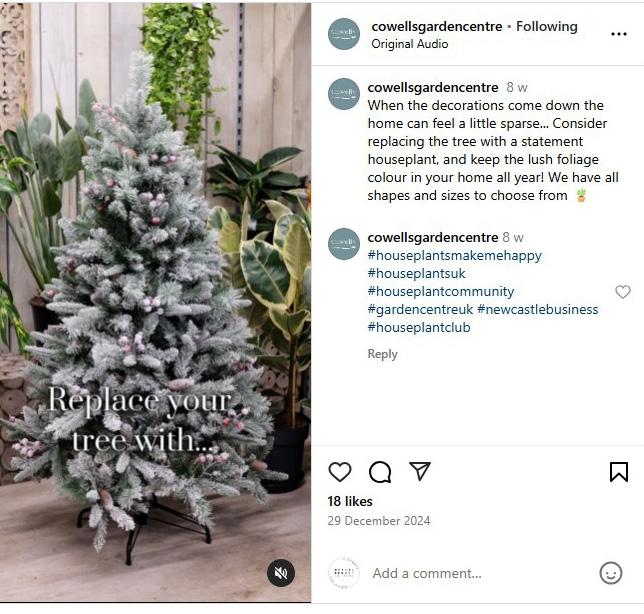
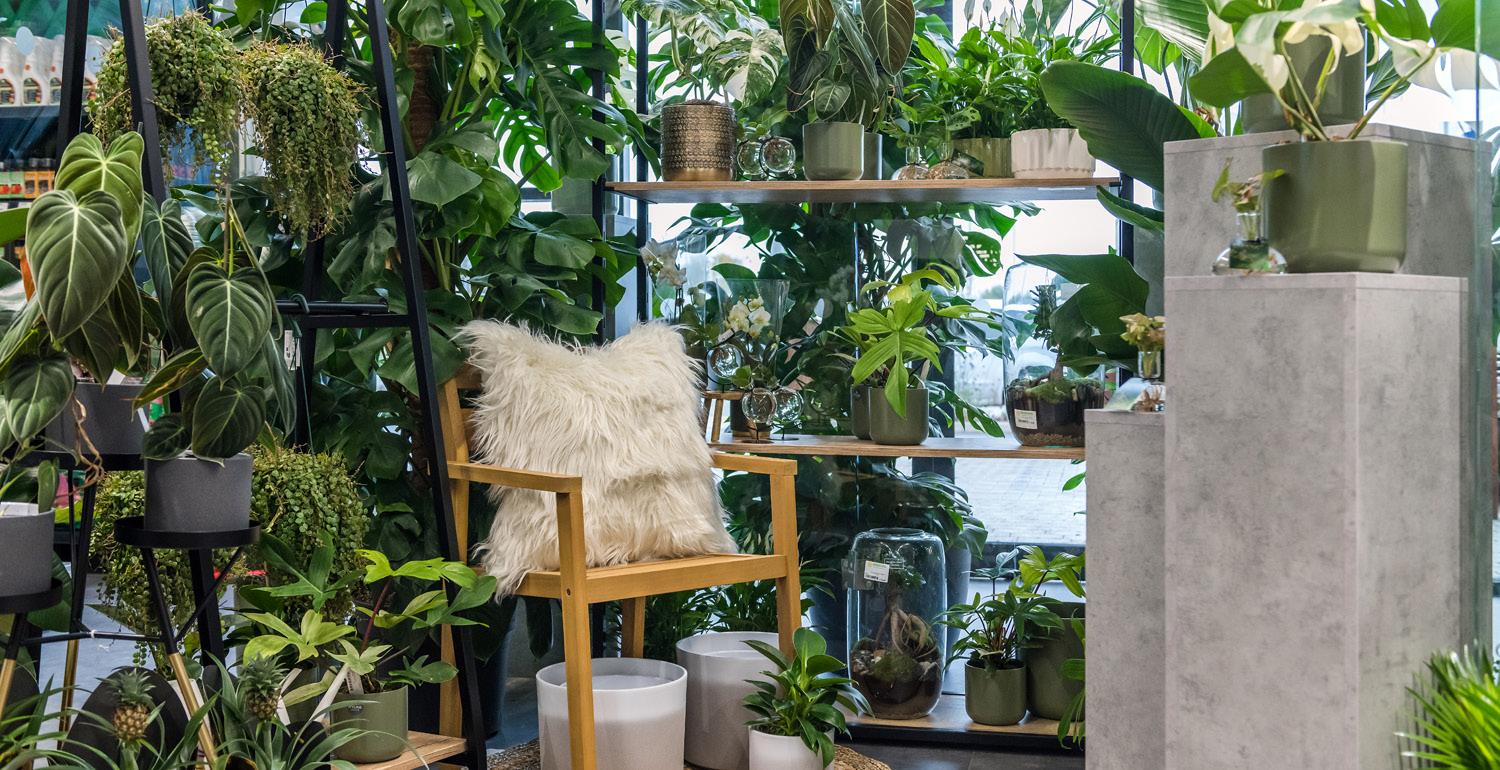
Garden centres are more than just retail spaces; they are destinations where customers can immerse themselves in nature, find inspiration, and enjoy a peaceful shopping experience. The design of a garden centre plays a crucial role in shaping customer perceptions and behaviours. By understanding the psychology behind garden centre design, businesses can create environments that not only enhance the customer experience but also drive sales and increase revenue.
The fi rst step in designing a successful garden centre is to create an environment that evokes positive emotions. Research shows that customers are more likely to spend time and money in spaces that make them feel happy and relaxed.
Incorporating plants, water features, and natural materials like wood and stone can create a calming and aesthetically pleasing environment. Studies have shown that exposure to nature reduces stress and improves mood, which can lead to increased spending.
Using colours strategically can influence customer emotions. For example, green is associated with tranquillity and growth, while bright colours like yellow and orange can create a sense of excitement and energy.
Providing comfortable seating areas allows customers to relax and spend more time in the garden centre. This can lead to increased browsing and higher sales.
Creating a sense of enclosure within a garden centre is a powerful design strategy that can significantly enhance the customer experience. This concept revolves around designing spaces that feel cosy, secure, and inviting, encouraging customers to spend more time exploring and engaging with the products. Here are some key elements and benefits of this approach:
Enclosed spaces within a garden centre can create a sense of intimacy and comfort. These areas can be designed as small garden rooms, alcoves, or even themed sections that provide a distinct and immersive experience. For example, a section dedicated to indoor plants can be designed with lower ceilings, soft lighting, and abundant greenery to create a cozy, enclosed feel. This design strategy makes customers feel more relaxed and encourages them to linger, which can lead to increased browsing and higher sales.
While creating enclosed spaces, it’s important to maintain visual connections to other parts of the garden centre. This can be achieved through strategic placement of pathways, windows, and open spaces that offer glimpses into different sections. These views create a sense of discovery and adventure, prompting customers to explore further. The anticipation of fi nding new and interesting products can enhance the overall shopping experience and increase the time spent in the store.
The layout of pathways is important for creating a sense of enclosure. Meandering pathways that gently curve and lead customers through different sections can make the space feel inviting and less overwhelming. In contrast, long, straight aisles can make customers feel rushed and less likely to browse. Designing pathways that encourage a relaxed pace helps garden centres create a more enjoyable shopping experience. A sense of enclosure also meets basic psychological needs for safety and comfort.
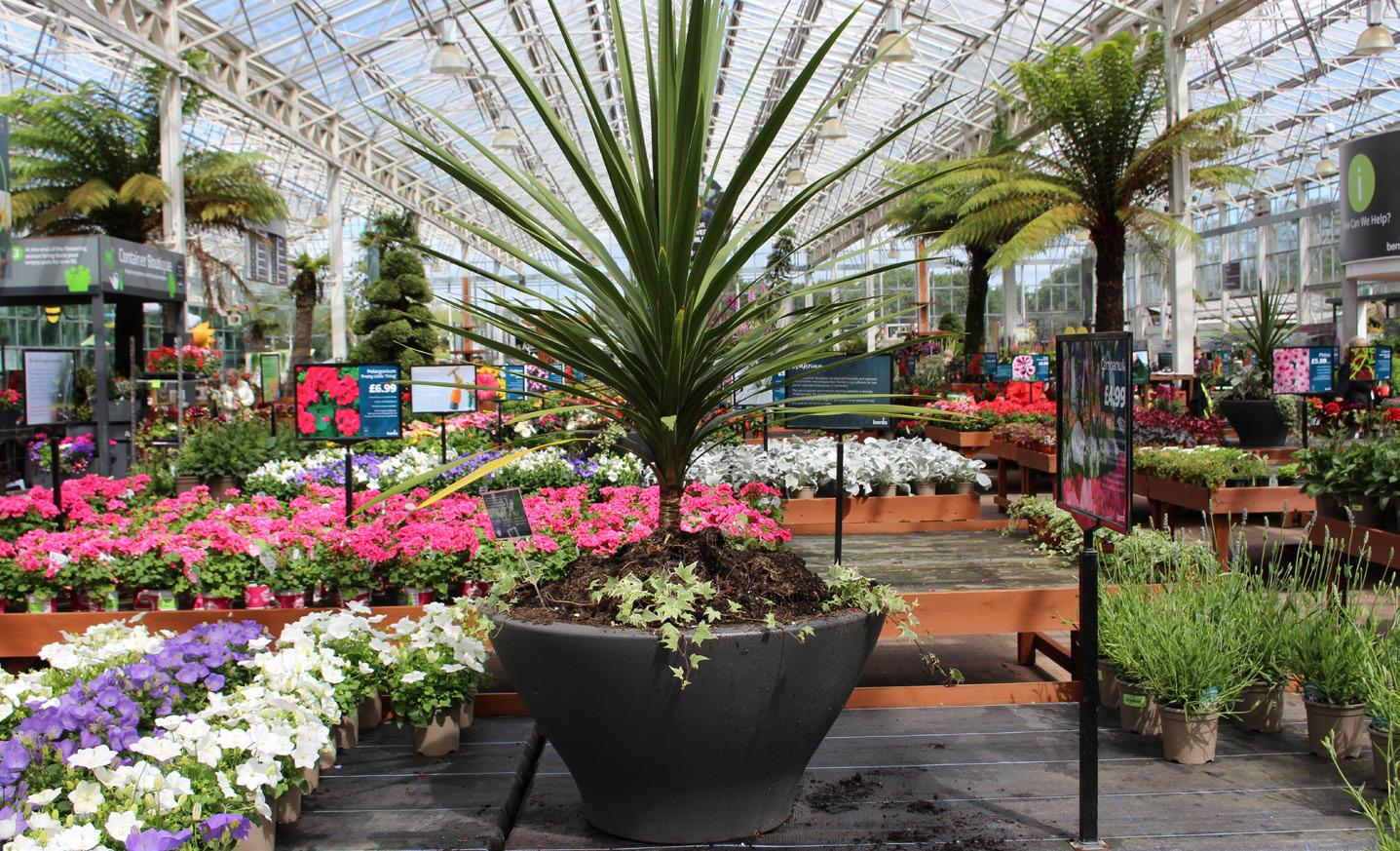
When customers feel secure and at ease, they are more likely to engage with the environment and make purchases. Enclosed spaces can also reduce sensory overload, making it easier for customers to focus on the products and enjoy their shopping experience. Creating a sense of enclosure within a garden centre is a strategic design choice that can enhance customer comfort, encourage exploration, and ultimately drive sales. By thoughtfully designing enclosed spaces, maintaining visual connections, and optimising pathways, garden centres can create inviting environments that resonate with customers and boost revenue.
Best practices for customer navigation effective customer navigation is crucial for creating a positive shopping experience in a garden centre. By implementing thoughtful design strategies, garden centres can help customers easily fi nd what they need, encourage exploration, and ultimately increase sales. Here are some best practices for optimising customer navigation:
Clear and effective signage is essential for guiding customers through the garden centre. Signs should be strategically placed at key points, such as entrances, exits, and intersections, to provide direction and highlight important sections. The design of the signage should be simple, using easy-to-read fonts and contrasting colours to ensure visibility. Additionally, incorporating symbols and icons can help communicate information quickly and effectively, especially for customers who may not be familiar with gardening terminology. Creating a “landing strip” area near the entrance of the garden centre allows
customers to orient themselves without feeling overwhelmed. This area can include floor plans, initial signage, and promotional displays that provide an overview of the store layout and highlight key products or sections. The landing strip serves as a welcoming space where customers can gather their bearings and plan their shopping journey, making the experience more enjoyable and less stressful.
Long, straight aisles can make customers walk faster and miss products, reducing the likelihood of purchases. Instead, garden centres should design shorter, segmented aisles that encourage browsing. Meandering pathways and curved aisles can create a more inviting and leisurely shopping experience, prompting customers to slow down and explore. This design approach increases the visibility of products and enhances the overall shopping experience for the customers.
Cross-selling involves placing complementary products together to prompt customers to buy additional items. For example, placing watering cans near indoor plants or garden gloves next to seed packets can encourage customers to purchase related products. This strategy not only increases sales but also enhances the convenience for customers, making it easier for them to fi nd everything they need in one place.
Interactive displays can engage customers and enhance their shopping experience. For instance, demonstration areas where customers can try out gardening tools or see how certain plants look in different settings can provide valuable information and encourage purchases. These displays create a hands-on experience that can make customers feel more connected to the products and more likely to buy.
Adjusting product displays based on seasonal demand ensures that customers fi nd relevant products easily. For example, showcasing frost covers and winter plants during colder months or vibrant flowers and outdoor furniture in spring can cater to seasonal needs and preferences. This approach keeps the garden centre dynamic and responsive to changing customer demands.
Implementing best practices for customer navigation can significantly enhance the shopping experience in a garden centre. By providing clear signage, creating welcoming landing strips, designing inviting aisles, utilising cross-selling strategies, and incorporating interactive displays, garden centres can help customers navigate the space effectively, leading to increased satisfaction and higher sales.

Understanding the science behind design decisions in garden centres can significantly enhance the shopping experience and drive sales. By leveraging principles from psychology, environmental design, and consumer behaviour, garden centres can create spaces that are both functional and appealing. Here are some key scientific insights:
Effective customer flow is crucial for maximising the time customers spend in the garden centre and the number of products they view. Studies show that well-designed pathways encourage exploration and reduce congestion, leading to higher sales.
Engaging multiple senses can enhance the shopping experience and increase the likelihood of purchases. Sensory engagement involves creating an environment that stimulates sight, touch, smell, and even sound.
Adjusting product displays based on seasonal demand ensures that customers fi nd relevant products easily. This approach keeps the garden centre dynamic and responsive to changing customer needs. Highlighting seasonal products, such as frost covers in winter or vibrant flowers in spring, can cater to customers’ immediate needs and preferences.
Leveraging data-driven decisions in garden
centre design can enhance operational eff iciency, customer satisfaction, and revenue. By utilising data from various sources, garden centres can make informed decisions that optimise product placement, inventory management, and marketing strategies.
Understanding customer preferences and behaviours is crucial for tailoring the shopping experience. Data from EPOS (Electronic Point of Sale) systems and customer loyalty programs can provide valuable insights into buying patterns.
Data-driven marketing allows garden centres to create targeted promotions and personalised offers. By analysing customer data, businesses can segment their audience and tailor promotions to specific groups.
Strategic product placement can significantly impact sales. Data analysis can identify high-traff ic areas within the garden centre and optimise the placement of highmargin. Placing popular or high-margin products at eye level to increase visibility and sales. Positioning small, high-margin items near checkout areas to encourage impulse purchases.
Effective inventory management is essential for reducing costs and ensuring product availability. Data analytics can help garden centres forecast demand, manage stock levels, and reduce waste.
Using historical sales data to predict future demand and adjust inventory levels accordingly. Implementing a fi rst-in, fi rstout (FIFO) system to ensure older stock is sold before newer stock, reducing waste and spoilage.
Data-driven decisions can also enhance the overall customer experience. By analysing customer feedback and behaviour, garden centres can identify areas for improvement and implement changes that increase satisfaction.
Data-driven decisions are a powerful tool for garden centres looking to enhance their operations and increase revenue. By utilising customer insights, optimising product placement, managing inventory effectively, and enhancing the customer experience, garden centres can create a more eff icient and profitable business. Embracing data analytics allows garden centres to stay competitive and meet the evolving needs of their customers.
The psychology of garden centre design involves creating environments that evoke positive emotions, encourage exploration, and facilitate easy navigation. By implementing best practices and leveraging scientific insights, garden centres can enhance the customer experience and drive sales. Good design is not just about aesthetics; it is a powerful tool for increasing revenue and building customer loyalty.



#FlexiTubChallenge Scan to watch now

•
•
•


•
•
•
•
•
•
•



Garden Centre Retail catches up with Colin Stanley, retail sales manager at Wyevale Nurseries to get his views on the best Perennial plants that garden centres should include in their plantarias this season.
Perennial plants are a cornerstone of garden centre offerings, providing year-round interest and structure to gardens across the UK. As the gardening season approaches, garden centres are gearing up to showcase a diverse range of perennial plants that promise to enhance any landscape. These hardy plants, which return year after year, are not only beloved for their resilience but also for their ability to provide continuous blooms and foliage, making them a favourite among gardeners.
The importance of perennial plants to the garden centre sector cannot be overstated. They represent a significant portion of plant sales, driving foot traff ic and customer engagement. Perennial plants are versatile, suitable for various garden styles and conditions, from sunny borders to shaded corners. Their ability to thrive in different environments makes them a reliable choice for garden centres aiming to meet diverse customer needs.
Perennial plants play a crucial role in sustainable gardening practices. Their long lifespan reduces the need for
frequent replanting, conserving resources and minimising environmental impact. As garden centres continue to promote eco-friendly gardening, perennial plants stand out as a key category that aligns with these values.
Colin, who trained at Pershore College and won its Horticultural Apprentice of the Year Award in 1981, has worked at Wyevale Nurseries for over 20 years and has 40+

years of industry experience. Well known and respected in the sector, he works closely with garden centres to meet stock needs and predict trends.
Geranium Rozanne
• The very best of the hardy geraniums
• A vigorously growing variety, which spreads to create ground cover. The neat bushy foliage contrasts with deep blue/purple and whitecentred flowers up to five centimetres across throughout summer and into autumn.
• Great for a wide range of uses, with ground cover over banks and within herbaceous borders.
• Voted as ‘Plant of the Centenary’ in celebration of the RHS Chelsea Flower Show’s 100th anniversary.
• Good for pollinators
• Grow in any moderately fertile soil apart from waterlogged soils, in full sun or partial shade
• May be susceptible to vine weevil, capsid bug and sawflies
• May be susceptible to downy mildew and powdery mildew

Lewisia Safi ra Sensation
• New to the market and a real garden showstopper, with spectacular flushes of coral and cream-bicoloured flowers in spring, often repeating flowering through to autumn.
• Grow in moderately fertile, neutral to acid, well-drained soil in full sun or light shade. Suitable for the alpine house, rock garden, or in the crevices of a retaining wall. Protect from winter wetness.
• May be susceptible to aphids, slugs and snails
• May be susceptible to neck rots in wet conditions
• Good for pollinators

Agapanthus Fireworks
• A beautiful Agapanthus with glorious bicolour blue and white blooms that explode into life. The umbels are supersize and densely packed with trumpet-shaped flowers
• Perfect for pollinators
• Humans/Pets (dogs, cats): harmful if eaten. Wear gloves and other protective equipment when handling.
• May be susceptible to slugs and snails and agapanthus gall midge
• In mild areas, grow in well-drained soil in a sunny, sheltered position. Otherwise, grow in a container and position it in full sun. Water during the growing season and liquid feed monthly from spring to flowering. Overwinter the whole container in a cold greenhouse.

Anemone Wild Swan
• Ideal to add some colour to a shady corner, this more compact variety has white flowers, with a distinctive grey-blue streak to the back of each petal. Flowering intermittently throughout May to November, its long blooming season and deep green foliage provide a great plant to add to any border.
• Winner of the RHS Chelsea Flower Show Plant of the Year Award in 2011 Grow in moist, fertile, humus-rich soil in sun or part shade. Mulch in spring and late autumn in cold areas.
• May be susceptible to leaf eelworms and damage from caterpillars and slugs
• May be susceptible to powdery mildews

• A real cottage garden favourite
• Soft, cloud-like flowers make this daisy ideal for the nooks and crannies. It also self-sows and flowers for nine months of the year. It just keeps going. Evergreen foliage makes this ideal for pots, beds, and borders amongst walls and other small areas.
• Perfect for pollinators
• Grows well in a wide range of conditions, from poor to fertile soils. It is drought tolerant, although it will produce a larger mound of foliage and flowers if it doesn’t dry out for long periods in summer. It thrives in full sun but will tolerate some shade.
• Generally pest and disease free.
• Easily trimmed & reflowered the same year.

Rodgersia Bronze Peacock
• Really strong and dramatic plant in the garden with its rich red new growth
• The darkest foliage of any Rodgersia, this choice plant produces stunning pink flowers in spring against huge bronze leaves that fan like a peacock’s tail.
• Grow in deep, fertile reliably moist soils in full sun or partial shade. Protect from cold and dry winds. Mulch to retain moisture
• Perennial, so will grow from the base each and every year
• May be susceptible to slug damage on young leaves but generally disease-free.

Colin, who trained at Pershore College and was presented with its Horticultural Apprentice of the Year Award in 1981, has worked for Wyevale Nurseries for more than 20 years and has 40+ years of industry experience. He is very well known and respected in the sector and enjoys working closely with garden centres to meet their stock requirements and to anticipate consumer trends.
For further details about Wyevale Nurseries, please call 01432 845 200 or visit www.wyevalenurseries.co.uk.














Domluca can be your perfect partner for your coffee shop or café.
Having a place to relax and socialise and enjoy great coffee and tea encourages your customers to spend more time and money within your garden centre.

Thinking of expanding your business to include a café?
Contact Paul and Kerry today on 01903 761178 who can share their expertise.
Paul and Kerry Ramsey have gained a wealth of experience in the coffee and café businesses that they are happy to share with you. This is your chance to tap into their profound knowledge of coffee and catering to help you make all the right decisions!



In the ever-evolving landscape of garden centres, the integration of quality coffee services has become a significant trend. To delve deeper into this phenomenon, we sat down with Caine Le Tissier, sales manager at Coffee King, to discuss their journey, offerings, and plans for the future. Coffee King, established in 2018, has been making waves in the coffee industry with their unique approach and commitment to quality.
• €4 billion spent on iced beverages in the UK food service channel in 2023
• This spend is forecasted to hit €5.5 billion by 2027
Having refreshing beverage options on your menu will help you unlock profit:
• More than one in two refreshing beverage occasions being consumed with food
• 60% of 18-24 year olds purchase an iced beverage out of home more than once a week
• Iced drinks command a higher price per litre compared to other soft drinks
• Iced drinks are growing faster than overall drinks average
• 78% of consumers purchase Seasonal and Limited Time Offer beverages
Thank you for joining us, Caine. Can you start by telling us a bit about Coffee King’s history and how it all began?
Absolutely Joe, Coffee King was born in 2016 by my dad, Sean Le Tissier, with a unique vision of selling high-quality speciality coffee that delivers the same exceptional service, taste, and cost no matter where you are.
In the beginning, we faced a lot of challenges, including COVID-19, which halted all our expansion plans. Initially, we focused purely on trade customers, but the pandemic pushed us to rapidly develop the business more toward e-commerce. During this time, my brother and I also built our first mobile barista van, which led to our franchise offering.
In 2021, we launched our business in Spain, marking our first international venture. By April 2024, we proudly opened our first café in Halifax, followed by two more in the Wirral. We have four more exciting sites lined up to open soon. From the beginning, we have always wanted Coffee King to be different and offer unique, innovative products. This vision has consistently driven our growth and continues to inspire our future.
That’s an impressive journey. Can you tell us more about the products you offer and how you position yourselves in the market?
We are a one-stop shop for coffee solutions, roasting our own coffee, supplying machines, and offering extras like syrups. We prioritise energy-efficient, eco-friendly products and partner with big suppliers like Da Vinci Gourmet and La Cimbali. Our goal is to make premium-quality coffee accessible to a wider market, beyond niche speciality enthusiasts.
How does Coffee King fit into the garden retail sector, and what can you offer to garden centres specifically?
Garden centres are a key focus for us. Every time I visit a garden centre, the café is always full, which shows there’s a huge demand. We aim to help garden centres reach a younger demographic through our offerings. By partnering with Da Vinci Gourmet, we get insights from market leaders, allowing us to create seasonal menus and drinks that appeal to this group. We offer a range of drinks, including iced beverages, hot chocolates, and flavoured lattes, which are popular with the social media generation.

What trends are you seeing in the coffee industry right now?
The main trend we’ve see is with iced and blended beverages. Pistachio and golden sugar are the big trending flavours for spring and summer. These will be popular in both hot and iced beverages. We stay ahead of trends by using data from our partners and creating limited-time offers that attract customers.
How involved are you in helping garden centres set up their coffee services?
We stay closely involved with every new client, assisting with setup, training, and providing the necessary equipment. We also create bespoke marketing materials, like posters and point-of-sale displays, tailored to each garden centre’s brand and goals. Our flexible approach ensures clients get exactly what they need.
Can you tell us more about your commitment to sustainability and how it aligns with the garden centre market?
Sustainability is a big part of our ethos. We use biodegradable takeaway cups and source our products responsibly. As a company, we are on a green journey, aiming to make our operations as eco-friendly as possible. This aligns well with garden centres, which are increasingly focusing on sustainability and attracting younger customers interested in eco-friendly products.
How important is consistency in your products and services?
Consistency is everything to us, and it’s why Coffee King was founded. We offer free training to help clients maintain high standards. We believe product presentation influences brand perception, so we only work with clients
who value our brand and are committed to maintaining quality.
Do you offer retail coffee bags for garden centres to sell?
Yes, we do. We’re expanding our capacity to offer more speciality coffee and house blends in smaller retail bags. We can also provide whitelabel options for garden centres that want to brand their own coffee.
Is there anything else you’d like to add about Coffee King and your plans for the future? We support our clients with full consultations to understand their needs and provide tailored solutions. Our goal is to help businesses succeed by offering high-quality, consistent products and excellent customer service.
Coffee King is poised to make a significant impact in the garden centre market with their commitment to quality, sustainability, and customer service. By offering tailored solutions and staying ahead of industry trends, we are well-positioned to help garden centres attract a diverse and loyal customer base.
High-Quality Ingredients: They source their coffee beans and other ingredients from reputable suppliers, ensuring that only the best quality products are used.
Partnerships with Industry Leaders:
Coffee King partners with well-known brands like Da Vinci Gourmet and La Cimbali, which provides them with access to high-quality products and market insights.
Energy-Eff icient and Environmentally Friendly Products: They focus on offering energy-eff icient and environmentally friendly products, such as biodegradable takeaway cups, which align with their commitment to sustainability.
Consistent Training and Support: Coffee King offers free training to their clients to ensure that their products are prepared and served consistently. They provide ongoing support and are willing to conduct monthly training sessions if needed.
Customisation and Flexibility: They work closely with their clients to understand their specific needs and provide tailored solutions. This includes helping with setup, training, and creating bespoke marketing materials.


Quality Control: They maintain strict quality control measures to ensure that their products meet high standards. This includes regular checks and feedback from clients to continuously improve their offerings.
Innovation and Adaptation: Coffee King stays ahead of industry trends by using data from their partners to create seasonal menus and limited-time offers that attract different customers. This helps them maintain a fresh and appealing product lineup.

Quality wood fired cooking
Unbeatable value
Wood Fired Ovens - Portable and multi-pizza
BBQ Accessories - Serving boards and cutters
Cookware - Pizza peels and cast iron
Fuel and Ignition - Wood pellets, kindling and logs

15% OFF all summer


Gardening has always been a beloved pastime, but recent advancements in technology and shifts in consumer preferences are transforming the tools we use. In 2025, several exciting trends are emerging in the gardening tools market, making gardening more efficient, sustainable, and enjoyable.
As garden centre owners, staying ahead of consumer trends is crucial to ensuring your business thrives in a competitive market. The gardening tools industry is experiencing rapid changes, driven by technological advancements, environmental concerns, and evolving consumer preferences. In 2025, several key trends are shaping the market, offering opportunities for garden centres to stock innovative and in-demand products that cater to the needs of modern gardeners.
Understanding these trends can help you make informed decisions about inventory, marketing strategies, and customer engagement. From the rise of battery-powered tools to the integration of smart technology, ergonomic designs, multi-functional tools, and sustainable materials, these developments are transforming the way people approach gardening. By aligning your product offerings with these trends, you can attract a diverse customer base, enhance customer satisfaction, and ultimately boost your sales.
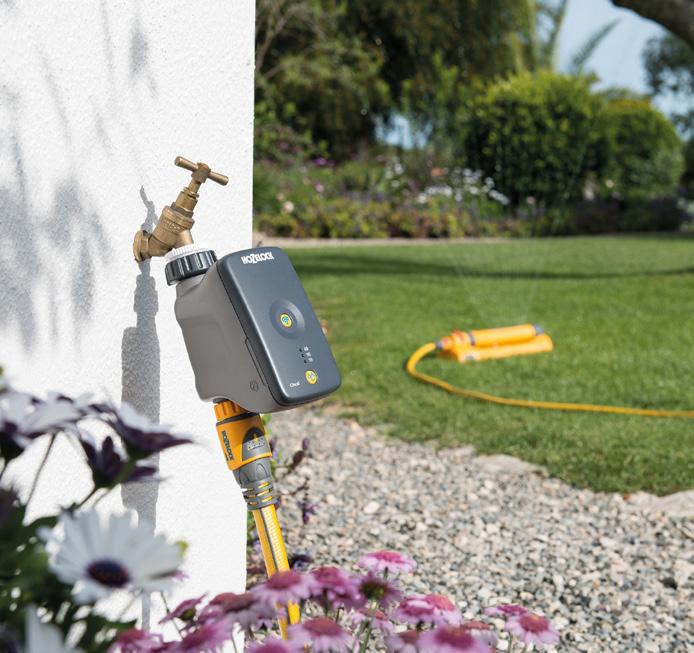
One of the most significant trends is the move towards battery-powered gardening tools. These tools are not only environmentally friendly but also offer several practical benefits. Battery-powered tools produce zero emissions during operation, making them a greener alternative to gas-powered tools. This helps reduce air pollution and contributes to a cleaner environment.
These tools operate much more quietly than their gas-powered counterparts. This is beneficial for both the user and their neighbours, as it reduces noise pollution and creates a more peaceful gardening experience.
Battery-operated tools are generally easier to start and use. They typically feature pushbutton starts, eliminating the need for pull cords. This makes them more user-friendly, especially for those who may struggle with the physical effort required to start gaspowered tools.
With fewer moving parts and no need for fuel, battery-powered tools require less maintenance. There’s no need to worry about changing oil, replacing spark plugs, or dealing with fuel stabilisers.
These tools are often lighter and portable than gas-powered options. They don’t require access to a power outlet, providing freedom of movement around the garden.
While the initial cost of battery-powered tools can be comparable to gas-powered ones, they tend to be cost-effective in the long run.
Users save money on fuel and oil, and the reduced maintenance needs can also lead to savings.
Improvements in battery technology have significantly enhanced the performance and reliability of these tools. Modern batteries offer longer run times and faster charging, making them more practical for a wide range of gardening tasks.

Smart gardening tools, such as automated watering systems and soil sensors, optimise the use of water and nutrients. By providing precise amounts based on real-time data, these tools help conserve resources and reduce waste.
Continuous monitoring of soil conditions, moisture levels, and weather forecasts allows gardeners to address potential issues before they become significant problems. This proactive approach leads to healthier plants and higher success rates.
Smart tools automate many gardening tasks, such as watering and fertilising, which reduces manual labour and saves time.
These types of tools provide valuable data and insights that help gardeners make informed decisions and smart choices.
Smart gardening technology is designed to be user-friendly, making it accessible to both novice and experienced gardeners. Easy-to-use apps and devices simplify garden management, allowing anyone to achieve successful results.
Smart gardening tools are particularly useful for urban and indoor gardening. Automated systems and compact devices make it easier to grow plants in small spaces, such as balconies or indoor gardens.
Many smart gardening tools can be integrated with existing smart home systems, allowing gardeners to control and monitor their gardens remotely. This integration enhances convenience and provides greater control over garden management.

Ergonomic tools are designed to fit the natural movements of the human body, reducing muscle strain and joint stress. This makes gardening more comfortable and less physically demanding.
Tools with ergonomic designs help maintain better posture while gardening. This can prevent back pain and other discomforts associated with prolonged bending and stooping.
By minimising repetitive motion and reducing strain, ergonomic tools help prevent common gardening injuries such as tendonitis and carpal tunnel syndrome.
Features like padded handles, non-slip grips, and lightweight materials make ergonomic tools more comfortable to use. This allows gardeners to work longer without feeling fatigued.
Ergonomic tools are particularly beneficial for older gardeners or those with physical limitations. They make gardening tasks easier and more manageable, promoting inclusivity in gardening.
Using ergonomic tools can contribute to long-term health by reducing the risk of chronic pain and injuries. This makes gardening a sustainable and enjoyable activity over the years.
Sustainable materials help reduce the depletion of natural resources. For example, using bamboo for tool handles is beneficial because bamboo is a fast-growing, renewable resource that helps prevent deforestation.
Tools made from recycled materials, such as reclaimed steel or aluminium, have a lower carbon footprint compared to those made from virgin materials.
By choosing tools that are repairable and recyclable, gardeners can significantly reduce the amount of waste sent to landfi lls. This promotes a circular economy where materials are reused and recycled.
Sustainable materials, such as biodegradable plant pots made from coir or pressed peat, decompose naturally and enhance soil health. This reduces reliance on plastic pots, which can contribute to soil and water pollution.
Tools made from high-quality, sustainable materials are often more durable and longlasting. This means they need to be replaced less frequently, reducing overall consumption and waste.
Purchasing tools made from sustainably sourced wood, such as those certified by the Forest Stewardship Council (FSC), supports responsible forest management practices. This helps maintain biodiversity, protect water resources, and support local communities.
There is a growing consumer preference for eco-friendly products. Stocking sustainable gardening tools can attract environmentally conscious customers and enhance your garden centre’s reputation as a responsible business.
Sustainable materials often have fewer harmful chemicals compared to conventional materials. This makes them safer for both the user and the environment.
The gardening tools market in 2025 is evolving to meet the needs of modern gardeners. From battery-powered and smart tools to ergonomic designs and sustainable materials, these trends are making gardening more accessible, eff icient, and environmentally friendly. Whether you’re a seasoned gardener starting out, embracing these trends can enhance your gardening experience and contribute to a greener planet.









As spring unfolds, gardeners are eager to rejuvenate their lawns and bring them back to life
With demand for lawn care products such as fertilizers, and grass seed rising, now is the time to stock up on the best lawn spreaders for the job.
Introducing The Handy Range of Spreaders - a must-have for lawn care throughout the year. From grass seeds to granular fertilizer, The Handy Drop and Broadcast Spreaders ensure quick, efficient, and consistent application.




THDS
Combining a lightweight design with a generous 27kg capacity and a wide 56cm spread width, The Handy THDS offers a quick and effortless way to cover large areas. Its adjustable feed control ensures precise application for maximum flexibility.

THS50
Blending a low weight build with smooth rolling pneumatic tyres and an expansive 3.65m spread-width (max.), this easy to use broadcast spreader from Handy is a comfortable and highly productive way to apply your chosen spread-medium! It weighs just 9.4kg and has a 23kg hopper-capacity
THS70HDUTY
Featuring robust metal gearing and combining a spacious 32kg-capacity hopper with an impressive 3.66m spread-width (max.), this heavy-duty broadcast spreader from Handy excels in terms of durability and large-area work-rate. Attractive features include pneumatic tyres and a fully adjustable feed-control.

ACCURATE SPREAD
Drop spreaders release seed or fertiliser accurately over lawns.

WIDE SPREAD
Broadcast spreaders are ideal for larger areas by throwing the subject outwards, covering a wider spreading pattern
Drive sales with the essential garden machinery... See the full range
Become a Stockist

If you would like to become a Stockist, please email sales@handys.co.uk call 01793 333220 or visit www.TheHandy.co.uk


